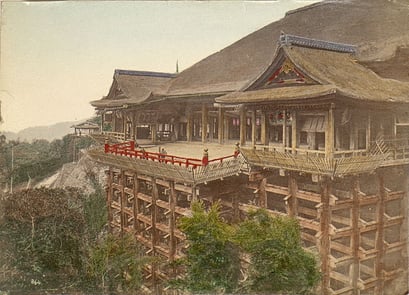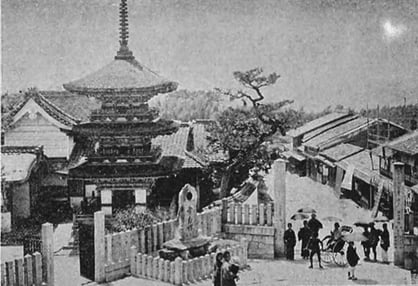🕓 2025/1/30
#観光地
Detailed explanation of the history and overview of Kiyomizu-dera Temple
-4.png?width=788&height=443&name=%E5%BC%81%E5%A4%A9%E5%A0%82%20(20)-4.png)
Table of Contents
- Overview of Kiyomizu-dera Temple
- History of Kiyomizu-dera Temple
- Must-Visit Attractions in Kiyomizu-dera Temple
- Events and Festivals at Kiyomizu-dera Temple
Introduction
Kiyomizu-dera Temple, located in the Higashiyama Ward of Kyoto, is one of Japan's most renowned tourist destinations, celebrated for its stunning scenery and historical significance. The temple is said to have been founded in 780 and has been cherished by many people since the Heian period. It is especially famous for its grand wooden stage, which gave rise to the phrase "to jump off the stage at Kiyomizu."
In this article, we will delve into the various aspects of Kiyomizu-dera's charm. From its history and highlights to the vibrant events and festivals held throughout the year, we aim to provide intriguing information for all visitors.
1. Overview of Kiyomizu-dera Temple
-3.png?width=584&height=328&name=%E5%BC%81%E5%A4%A9%E5%A0%82%20(19)-3.png)
Kiyomizu-dera Temple, a historic temple located in the Higashiyama Ward of Kyoto, derives its name from the Otowa Waterfall within the temple grounds. The temple was founded in 780 and attracts numerous tourists and worshippers, especially during the cherry blossom and autumn foliage seasons.
The temple is particularly famous for its grand wooden stage, constructed on thousands of wooden pillars. This stage is the origin of the phrase "to jump off the stage at Kiyomizu." From the stage, visitors can enjoy panoramic views of Kyoto City and the surrounding mountains, which are especially beautiful during the cherry blossom and autumn foliage seasons.
-May-25-2024-03-59-42-4390-AM.png?width=579&height=326&name=%E5%BC%81%E5%A4%A9%E5%A0%82%20(16)-May-25-2024-03-59-42-4390-AM.png)
Kiyomizu-dera is also registered as a UNESCO World Heritage site, recognizing its historical value and beauty on an international level. The temple grounds, which spread across the slopes of Mount Otowa, contain over 30 Buddhist structures and host numerous cultural events and seasonal festivals throughout the year. The spring cherry blossoms and autumn foliage are particularly notable attractions, drawing many visitors during these seasons.
-2.png?width=582&height=327&name=%E5%BC%81%E5%A4%A9%E5%A0%82%20(22)-2.png)
The temple precincts consist of multiple buildings and beautiful gardens, and the main worship route is bustling with visitors. The principal deity of Kiyomizu-dera, the Eleven-faced Thousand-armed Kannon, is highly revered by devotees and is a hidden Buddha that is only revealed on special occasions. At the Otowa Waterfall, worshippers are offered three types of water (longevity, academic success, and love fulfillment), each believed to bring different blessings.
The charm of Kiyomizu-dera lies not only in its architectural beauty but also in the harmony between the temple grounds and the surrounding nature, offering a space where visitors can feel the history and culture of Kyoto. Each building and garden highlights the traditional beauty of Japan.
2. History of Kiyomizu-dera Temple
1. Foundation and Early History
Kiyomizu-dera Temple is located in Kyoto and its establishment dates back over 780 years, to the Heian period, initiated by the monk Enchin. According to legend, Enchin chose this location following a divine revelation and was guided by the pure waters of the Otowa Waterfall to decide to establish the temple. Early Kiyomizu-dera became widely known through miraculous stories associated with these pure waters (Otowa no Mizu) and the Nagi tree.
2. Reconstruction in the Edo Period
In 1633, under the orders of Tokugawa Iemitsu, the main hall was rebuilt. The stage constructed during this period, known as the "stage of Kiyomizu," became an iconic feature of the temple, attracting many visitors with its panoramic views of Kyoto. This stage is a testament to Japanese architectural prowess and has been cherished by many people.
3. Meiji Period and the Separation of Shinto and Buddhism
The Meiji-era policy of separating Shinto and Buddhism (Shinbutsu Bunri) significantly impacted Kiyomizu-dera. This policy legally separated Buddhist temples from Shinto shrines. Despite these changes, Kiyomizu-dera maintained its status as a Buddhist temple and continued to receive support from the local community and devotees while adapting to evolving social challenges.
4. UNESCO World Heritage Registration
In 1994, Kiyomizu-dera was recognized for its historical and cultural value and was registered as a UNESCO World Heritage site. This registration was a symbolic event acknowledging the temple as a globally important cultural asset, attracting many visitors from around the world. Being recognized as a World Heritage site has facilitated international support for the preservation activities of Kiyomizu-dera and provided more opportunities for people to visit this historic place.
5. Kiyomizu-dera in Modern Times
In modern times, Kiyomizu-dera continues to preserve many important cultural properties, sharing Japanese culture and history widely through them. Notably, the statue of the Thousand-armed Kannon, designated as an Important Cultural Property, is rarely displayed and is only shown to the public on special occasions once every 33 years. Such rare exhibitions provide a unique and special experience for many devotees and tourists.
Additionally, Kiyomizu-dera hosts various cultural events throughout the year, contributing to the preservation and development of local culture. For example, in spring, there are special evening visits aligned with the cherry blossom season, and in autumn, the temple is illuminated against the beautiful backdrop of autumn foliage. These events deeply impress visitors and enhance the cultural value of Kiyomizu-dera.
3. Must-Visit Attractions in Kiyomizu-dera Temple
Kiyomizu-dera Temple is a historic temple located in the Higashiyama Ward of Kyoto and is one of Japan's most famous tourist destinations. Here are some of its notable highlights:
■ Nio-mon (Deva Gate)
The main entrance to Kiyomizu-dera Temple, known for its magnificent two-story structure. After being destroyed in the civil war of 1469, it was rebuilt around 1500. It underwent extensive restoration, including disassembly, in 2003. This gate is approximately 10 meters wide, 5 meters long, and 14 meters high, showcasing the unique architectural style of the period in which it was rebuilt.
■ Sanju-no-to (Three-storied Pagoda)
This pagoda stands out as a cultural symbol among the historic temples in Kyoto. It is one of the largest pagodas in Japan, standing at about 32 meters tall. The original structure was built in 847, and the current building was reconstructed in 1632 with the support of Tokugawa Iemitsu. It is characterized by its vibrant red color and elegant architectural style, making it a prominent feature within the temple grounds.
Although the interior of the pagoda is not open to the public, its architectural beauty and historical significance make it an important spot for visitors.
■ Main Hall and Stage
Known as the "Stage of Kiyomizu," it offers breathtaking views of Kyoto City and the surrounding nature from a height of about 13 meters. The main hall was originally constructed in the Heian period and has undergone numerous renovations over the years. This building exemplifies the evolution of Japanese architectural techniques and houses many important statues, including the Thousand-armed Kannon.
The stage of Kiyomizu allows visitors to enjoy the seasonal landscapes, with cherry blossoms in spring and autumn foliage captivating many. These views attract numerous photography enthusiasts and nature lovers, especially during the cherry blossom and autumn foliage seasons.
■ Otowa Waterfall
Otowa Waterfall, located within the temple grounds, is a notable spot and the namesake of the temple. The waterfall splits into three streams, each symbolizing health, longevity, and academic success. Visitors drink from these waters to receive their respective blessings. Known as "Otowa Reisu," this water is also available for purchase, allowing visitors to enjoy it at home.
The waterfall also has historical significance, being the meeting place of the founder Enchin and the temple's patron Gyoei Koji. The site enshrines the deity Fudo Myo-o, and a special early morning service is held on the 28th of each month, providing a more solemn atmosphere for visitors on these days.
■ Senju Stone Buddha Statues
This group of stone Buddha statues holds significant historical value, many of which survived the anti-Buddhist movement of the Meiji era. Many statues were saved and brought to Kiyomizu-dera by common people when numerous stone statues were destroyed in the city.
These stone Buddha statues are recognized as part of the World Cultural Heritage site in Higashiyama, Kyoto. Their spiritual value and importance as cultural heritage assets are widely acknowledged.
4. Events and Festivals at Kiyomizu-dera Temple
■ Light-Up Events
The light-up events at Kiyomizu-dera are held especially in spring and autumn, where the temple and gardens are illuminated in a magical light. These events highlight the beauty of the cherry blossoms in spring and the autumn foliage, attracting many tourists and photography enthusiasts. During this period, special evening visits are possible, allowing visitors to enjoy the temple in a different atmosphere.
■ Seiryu-e (Blue Dragon Festival)
The Seiryu-e is a special spring event at Kiyomizu-dera dedicated to the spirit of the Blue Dragon. A giant painting of the Blue Dragon is offered during this event. Participants pray to the Blue Dragon as it parades through the temple grounds, seeking protection from evil spirits and personal safety.
■ Xuanzang Sanzo-e (Xuanzang Memorial Ceremony)
The Xuanzang Sanzo-e honors the achievements of the Chinese monk Xuanzang, celebrating his translation of scriptures and the spread of Buddhist teachings. This ceremony reenacts Xuanzang's travels with the scriptures, paying tribute to his spiritual journey and scholarly contributions. This event symbolizes the importance of learning and knowledge, holding deep significance for many monks and devotees.
Conclusion
Finally, Kiyomizu-dera offers more than just a tourist destination. This place, where historical background and magnificent natural beauty coexist, is an excellent spot to experience the essence of Japanese culture. Various cultural events and seasonal festivals held throughout the year provide visitors with memorable experiences.
The cherry blossoms in spring and the autumn foliage are especially breathtaking, and the light-up events accentuate their beauty in a magical atmosphere. By visiting Kiyomizu-dera, you can cleanse your mind and experience the depth of Japanese traditions and culture.




.jpg?width=526&height=351&name=001_L1009508%20(1).jpg)
-May-25-2024-03-59-41-9721-AM.png?width=581&height=327&name=%E5%BC%81%E5%A4%A9%E5%A0%82%20(17)-May-25-2024-03-59-41-9721-AM.png)
-3.png?width=577&height=325&name=%E5%BC%81%E5%A4%A9%E5%A0%82%20(23)-3.png)
-3.png?width=581&height=326&name=%E5%BC%81%E5%A4%A9%E5%A0%82%20(26)-3.png)
-3.png?width=580&height=326&name=%E5%BC%81%E5%A4%A9%E5%A0%82%20(24)-3.png)
-3.png?width=581&height=327&name=%E5%BC%81%E5%A4%A9%E5%A0%82%20(25)-3.png)
-3.png?width=583&height=328&name=%E5%BC%81%E5%A4%A9%E5%A0%82%20(21)-3.png)

